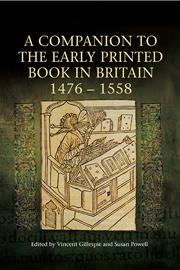Book contents
- Frontmatter
- Contents
- List of Illustrations
- List of Contributors
- Preface
- Acknowledgements
- Abbreviations
- Chronology of the Period
- Introduction
- I THE PRINTED BOOK TRADE
- 1 From Manuscript to Print: Continuity and Change
- 2 Printers, Publishers and Promoters to 1558
- 3 The Latin Trade in England and Abroad
- II THE PRINTED BOOK AS ARTEFACT
- III PATRONS, PURCHASERS AND PRODUCTS
- IV THE CULTURAL CAPITAL OF PRINT
- Index of Manuscripts
- Index of Printed Books
- General Index
2 - Printers, Publishers and Promoters to 1558
from I - THE PRINTED BOOK TRADE
Published online by Cambridge University Press: 05 April 2014
- Frontmatter
- Contents
- List of Illustrations
- List of Contributors
- Preface
- Acknowledgements
- Abbreviations
- Chronology of the Period
- Introduction
- I THE PRINTED BOOK TRADE
- 1 From Manuscript to Print: Continuity and Change
- 2 Printers, Publishers and Promoters to 1558
- 3 The Latin Trade in England and Abroad
- II THE PRINTED BOOK AS ARTEFACT
- III PATRONS, PURCHASERS AND PRODUCTS
- IV THE CULTURAL CAPITAL OF PRINT
- Index of Manuscripts
- Index of Printed Books
- General Index
Summary
The Printers: 1476–91
Printing did not begin in England until around 1476, when William Caxton set up a shop in Westminster, within the precincts of the Abbey there. The earliest work he printed there seems to have been John Russell's Propositio (STC 21458) completed before September of that year. But he already had considerable experience of the new technology of moveable type on the Continent before he returned to his native land; in 1472 he had been involved in the printing of several books at Cologne, including an edition of a very large medieval encyclopaedia, Bartholomaeus Anglicus's De proprietatibus rerum. Subsequently, he was involved in the printing of a number of books in Bruges and very probably in Ghent, including the earliest book printed in English, his translation of Raoul le Fèvre, The Recuyell of the History of Troy (1473–74, STC 15375), which was printed alongside the French original, Le recueil des histoire de Troie (c.1474), and The Game and Play of Chess (1474, STC 4920). The translations of both texts from the French were Caxton's own work.
England was the first country where printing was introduced by a native. Caxton (c.1420–92) was born in Kent and began a mercantile career in London before spending much of his commercial life in the Low Countries. When he returned to England to set up its first printing press, he brought to the country of his birth the Continental expertise he had acquired, as well as more tangible debts to Europe reflected most directly in his use of type cast from matrices made by his former Cologne collaborator, Johannes Veldener.
- Type
- Chapter
- Information
- Publisher: Boydell & BrewerPrint publication year: 2014

